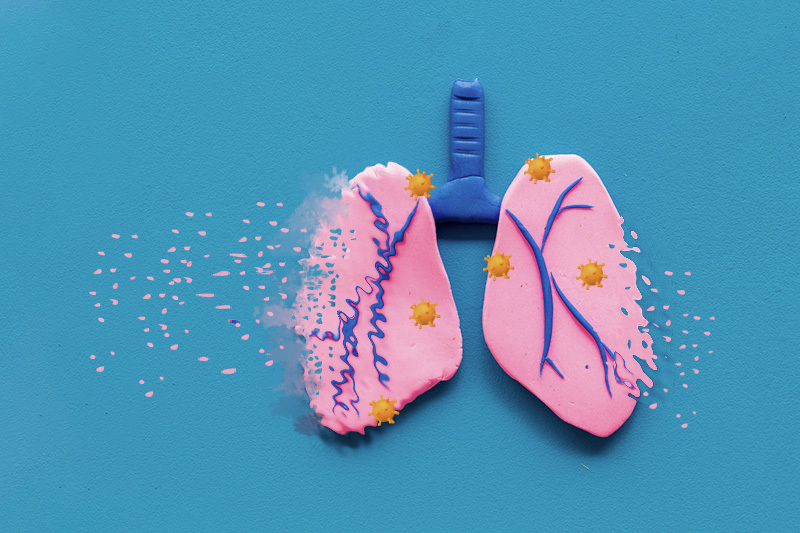Type III interferon in COVID-19: Protective or harmful?

Our immune system makes interferons and other cytokines to help us fight viruses. But in COVID-19, we’ve learned that they can also contribute to damaging, potentially life-threatening lung inflammation. New work published yesterday in the journal Science helps tease out the good from the bad for one interferon of interest: type III.
. At least two clinical trials are testing type III interferon as a treatment for COVID-19, but this new work suggests it may cause harm if given later in the illness.
. When the virus reaches the lung, type III interferon may disrupt the lung’s protective surface barrier, raising risk of bacterial “superinfections.”
Recent evidence suggests that type III interferon, a.k.a. interferon lambda (λ), can fight viral infection while also limiting inflammatory damage. That has led to at least two clinical trials to test them as a treatment for COVID-19.
But the new study raises a caveat. Researchers at Boston Children’s Hospital, with collaborators in Italy, provide evidence that type III interferon increases the risk of life-threatening bacterial “superinfections” in the lung. These superinfections can happen in both influenza and COVID-19. The investigators caution that type III interferons given later in the course of COVID-19 could do more harm than good.
“Our data indicate that the new coronavirus, SARS-CoV-2, inhibits interferon production in the upper airways,” says Ivan Zanoni, PhD, an immunologist at Boston Children’s and the study’s senior investigator. “This weakens the immune response and helps the virus survive. But when the virus reaches the lower airways, there is an exuberant immune response, including an increase in type III interferons that we think is harmful.”
Interferon in COVID-19: Location, timing are key
The team first tested samples from patients with severe COVID-19 and healthy controls. Interferon III was not much increased in the patients’ nasopharyngeal swab samples. But it was markedly elevated in their lung fluid.

Next, the researchers exposed mice to synthetic viral RNA to mimic the effects of SARS-CoV-2 infection in the lower airways. Interferon III levels rose markedly in the animals’ lungs as compared with control mice. Continued production of interferon III prevented the lungs from maintaining their protective surface barrier.
This, in turn, made the mice more susceptible to lethal bacterial infections from Staphylococcus aureus. Experiments showed increased amounts of bacteria in the lungs and higher mortality as compared with control mice.
“There’s still a lot to understand, but it looks like location and timing of interferon production are key,” says Zanoni. “Early during SARS-CoV-2 infection, when the virus is in the upper airways, it might be important to intervene with recombinant interferons and other antivirals. But later on, when inflammation increases in the lower airways, it will be important to block the signaling cascade initiated by interferons and other inflammatory cytokines, possibly with the anti-inflammatory drugs.”
Achille Broggi, PhD, Sreya Ghosh, PhD, and Benedetta Sposito of Boston Children’s were first authors on the paper. The study was supported by the National Institutes of Health, the National Institute of Allergy and Infectious Diseases, the Crohn’s and Colitis Foundation, the Italian Association for Cancer Research, Fondazione Regionale per la Ricerca Biomedica, and Ministero della Salute, Ricerca Finalizzata.
Learn more about Boston Children’s response to COVID-19 and coronavirus research at the hospital.
Related Posts :
-

No limitations: How Flora found answers for MOG antibody disease
Flora Ringler’s fifth birthday didn’t turn out as she had hoped. She and her family were vacationing in ...
-

What orthopedic trauma surgeons wish more parents knew about lawnmower injuries
Summer is full of delights: lemonade, ice cream, and fresh-cut grass to name a few. Unfortunately, the warmer months can ...
-

Partnering diet and intestinal microbes to protect against GI disease
Despite being an everyday necessity, nutrition is something of a black box. We know that many plant-based foods are good ...
-

‘They never stopped trying to figure out what was happening’: RyennAnne’s encephalitis journey
When 5-year-old RyennAnne Hurst developed a bad sore throat last summer, her doctor thought she might have strep and prescribed ...





